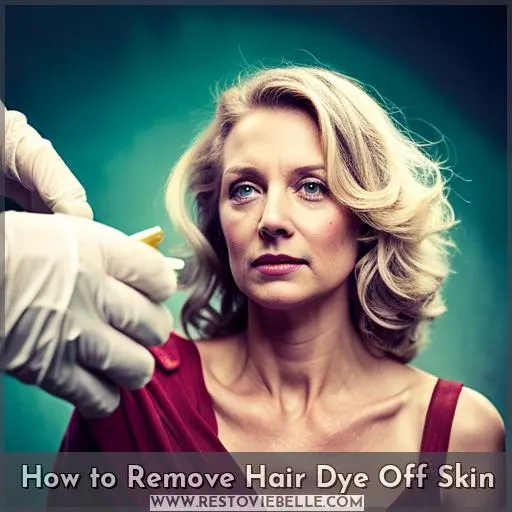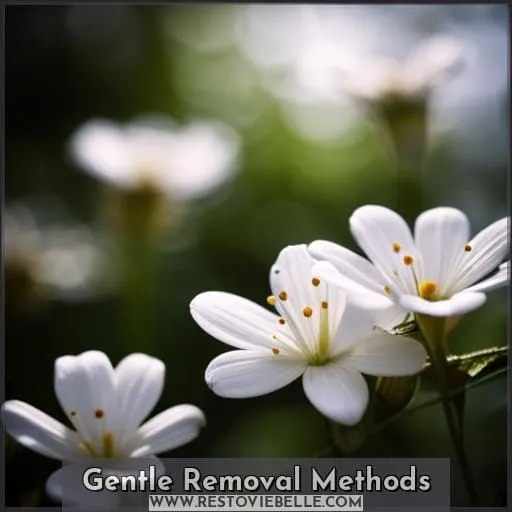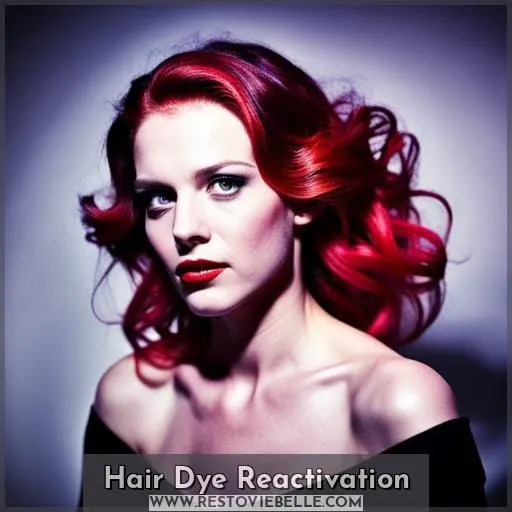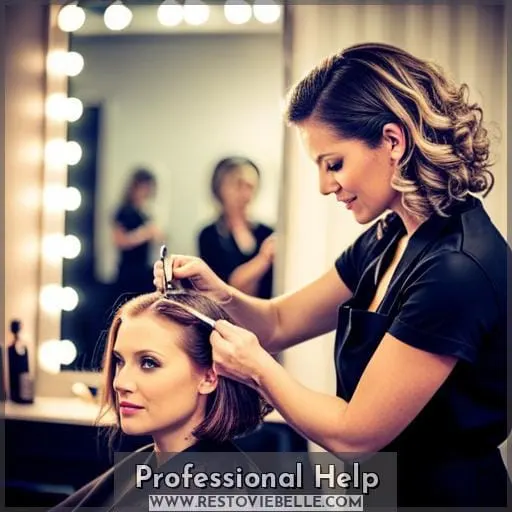This site is supported by our readers. We may earn a commission, at no cost to you, if you purchase through links.
 Are you one of the many people who have dyed their hair at home and been left with dye stains on their skin? According to a survey by Clairol, 72% of those who have colored their hair at home experienced staining.
Are you one of the many people who have dyed their hair at home and been left with dye stains on their skin? According to a survey by Clairol, 72% of those who have colored their hair at home experienced staining.
Removing unwanted dyes from your skin can be tricky, but luckily there are ways to get it off safely without damaging your delicate complexion.
Table Of Contents
Key Takeaways
- Use petroleum jelly, moisturizer, or lip balm as barriers.
- Wear gloves for hand and nail protection.
- Seek professional help for stubborn stains.
- Avoid hair dye contact with eyes, rinse with water if it occurs.
Preventive Measures
If you plan to dye your hair, it is important to take preventive measures. To avoid staining your skin with the dye, apply a thin layer of petroleum jelly as a barrier and use moisturizer or lip balm around your hairline.
Additionally, wearing gloves during the process will also help prevent staining on hands and nails.
Use Petroleum Jelly to Prevent Stains
To help protect your skin from dreaded hair dye stains, apply a generous layer of petroleum jelly around the edges of your hairline before you start coloring. Petroleum jelly has many benefits when it comes to preventing and protecting against staining: its thick consistency helps create an effective barrier between the dye and the skin; it is easy to spread over larger areas, and it prevents the product from drying out on contact with air.
Apply Moisturizer or Lip Balm Around Hairline
Smooth a layer of moisturizer or lip balm around your hairline before dyeing to create an invisible barrier against stains. Lip balm and skin moisturizers offer multiple benefits, such as adding hydration and protecting delicate areas from dyes that could cause irritation.
Alternatives like petroleum jelly can also be used for additional protection but may not provide the same level of moisture as natural products.
Wear Gloves During Hair Dyeing
Slip on a pair of gloves before you start dyeing your hair to protect your skin from staining. Glove benefits include protection against dyes, chemicals, and infection. Latex or Nitrile is best for comfort and flexibility.
Make sure to get the proper fit for hand protection. Disposable options are also available.
DIY projects require extra caution. Wear gloves during hair dyeing to prevent skin stains! Hand protection is key when using home dyes, so keep those fingers safe with latex or nitrile.
Gentle Removal Methods
If you’re looking for gentle methods to remove hair dye from your skin, then try makeup remover, apply olive oil and wash off after 8 hours, or use soap and warm water. All three of these options provide an easy way to clean up any accidental messes without causing too much irritation.
Try Makeup Remover
Eliminate unwanted hair dye from your skin with ease – just grab a makeup remover pad! Alternatives like gentle cleansing oil or soap and water are also effective. Quick stain removal can be achieved by using cosmetic remover for hair dye, and even the very same hair dye may help remove certain stains.
Skin-friendly options exist that work to preserve delicate skin while effectively removing stubborn traces of color from hands, face, and other areas.
Apply Olive Oil and Wash Off After 8 Hours
Coat your skin with olive oil and let it sit for eight hours before washing off for an easy way to remove hair dye. Olive oil benefits are numerous, including its powerful ability to break down residue from the hair dye on your skin.
Its overnight remedy is a simple yet effective solution that can be used in DIY stain removal and doesn’t require any harsh abrasives or chemicals.
The natural oils present in this home treatment provide safe, gentle cleansing while also nourishing and hydrating your skin.
Try Soap and Warm Water
Gently scrub off any stubborn hair dye with a warm, soapy washcloth. Try using skin-friendly soap and water to quickly cleanse your skin of the stain. Opt for preventive techniques like moisturizing or using barrier creams when applying the dye next time.
Mild Abrasives
If you’re looking for mild abrasives to help remove hair dye from your skin, toothpaste with baking soda and a dish soap and baking soda paste are both effective options. Creating the right combination of these natural ingredients can help safely exfoliate away staining without causing further damage or irritation to delicate skin.
Use Toothpaste With Baking Soda
Tackle stubborn hair dye stains on your skin with toothpaste and baking soda – a mild abrasive that can help scrub away the color without damaging delicate skin. Baking soda is incredibly beneficial for its natural exfoliating properties, which makes it perfect for removing unwanted hair dye.
Use a combination of an all-natural, gentle toothpaste and baking soda to create a DIY stain remover solution.
This effective cleansing method removes even tough stains while being safe enough to use on sensitive areas like around the eyes or mouth.
With these tricks up your sleeve, you’ll have no problem keeping those pesky hair dye stains at bay!
Create Dish Soap and Baking Soda Paste
Mix a paste of dish soap and baking soda, then apply it directly to the affected areas for an effective way to lift stubborn hair dye stains from your skin. Baking soda benefits include removing hair dye due to its natural pH balance and abrasive properties, making it suitable for DIY stain removal.
The combination of dish soap with baking soda creates a gentle yet powerful remedy that’s both skin-friendly and capable of fighting tough stains without any harsh chemicals or bleaches.
Try out this easy recipe today for all kinds of stain-fighting solutions!
Alcohol-Based Solutions
If you’re looking for a way to remove hair dye from your skin, alcohol-based solutions can be an effective solution. From rubbing alcohol to nail polish remover, there are several options available that will help you get rid of any unwanted color stains.
Consider Rubbing Alcohol (Cautiously)
Be cautious when using rubbing alcohol to remove hair dye from your skin. It can be an effective method, but it should only be used as a last resort and with great caution due to its potential for skin irritation.
Always read the instructions on any product you use and take the necessary safety measures, such as wearing gloves.
If you opt for this approach, test it first in an inconspicuous area of your body before applying it all over your skin. This will help make sure that no further damage or discoloration is caused by using rubbing alcohol on sensitive areas like around the eyes or ears.
Use Nail Polish Remover (on Hands, Cautiously)
Take caution when using nail polish remover on your hands to remove stubborn hair dye stains. The powerful solution can be harsh and cause irritation. Before applying, consider alternative solvents like rubbing alcohol or dish soap as a gentler method of stain removal.
For added skin safety, apply barrier creams such as Vaseline or shea butter lotion before handling the product. When finished with the application process, practice cautionary measures by quickly wiping up spills and avoiding contact with sensitive areas around the eyes and mouth.
With these prevention techniques in mind, you can properly use nail polish remover for hair dye stain removal while keeping your skin safe from harm!
Hair Dye Reactivation
Reactivating hair dye with more product and then wiping it off can help get rid of stubborn stains. Creative uses include color correction or time-saving techniques like applying a second coat before the first is dry.
Alternative methods are also worth exploring. For example, you can try reactivating the dye with glass cleaner or AHA peel pads.
To prevent staining your skin in the first place, remember to wear gloves when dying your hair and quickly wipe up spills during application. However, if you do find yourself dealing with post-dye messes, there are several useful hacks to clean up afterwards.
Toothpaste mixed with baking soda makes an effective scrub for tougher areas. Another option is to leave olive oil on overnight to help break down remaining traces of color.
With these tips in mind, anyone looking for quick solutions should be able to tackle their own hair stain removal safely at home.
Professional Help
If your hair dye stains are proving difficult to remove, consider seeking assistance from a salon or color specialist. Skin care professionals have experience in removing long-term stains and can provide specialized services for those stubborn areas.
A consultation with an experienced technician is the best way to assess the situation and recommend treatment options. They may suggest using dish soap and baking soda paste or toothpaste with baking soda for dye removal.
If necessary, they may even suggest using nail polish remover on hands. However, caution should be taken when attempting this method of stain removal at home.
To enjoy optimal results, it’s important to book a salon appointment that allows plenty of time for thoroughly cleaning up any residual product left behind after dying hair.
Remember to Exercise Caution and Prioritize Safety
When using harsher methods like bleach, always remember to exercise caution and prioritize safety when applying any substances near sensitive areas like the eyes – after all, why take unnecessary risks?
Here are five essential safety precautions you can follow:
- Apply barrier creams such as Vaseline or shea butter lotion before starting.
- Always wear gloves while handling hair dye products.
- Quickly wipe up spills during the process to prevent staining your skin and clothes with dye residue that might be hard to remove later on!
- Avoid contact between hair dyes and your eyes at all costs – if it does happen, rinse immediately with water for 15 minutes or more until irritation subsides completely!
- Lastly, use a mild soap solution afterwards to cleanse any affected area of skin; this will help ensure no long-lasting damage has been done by the chemicals in hair dye products themselves!
Safety should always come first when working with potentially hazardous materials; following these guidelines can help protect both you and those around you from harm due to exposure of harmful substances found in most home haircare products today.
Conclusion
Removing hair dye off skin can be a difficult task, but with the right preventive measures and removal methods, you can be sure to get the job done safely and effectively. By using petroleum jelly or moisturizer as a barrier, applying olive oil and soap for gentle removal, and trying mild abrasives like toothpaste with baking soda and dish soap, you can get the stubborn hair dye off your skin.
If these methods don’t work, consider using alcohol-based solutions, reactivating the color with more dye, and seeking professional help if necessary. Always remember to exercise caution when using harsher methods and prioritize safety when applying any substances to sensitive areas like the eyes.
With these tips, you can safely remove hair dye off skin.













